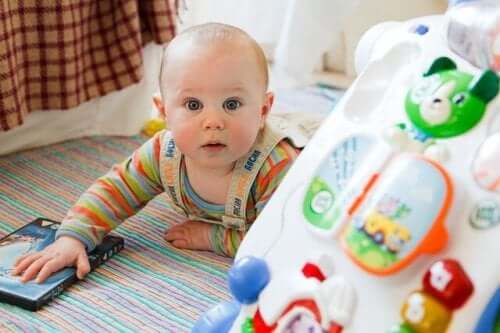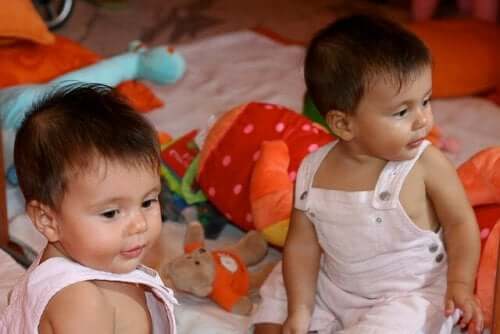7 Signs that Indicate Speech Problems in Babies

Speech problems in babies aren’t easy to detect in the first months of life, because, as babies don’t speak, we don’t usually focus a lot of attention on this aspect. However, when a young baby finally seems to have said something, we’re very attracted to the idea of thinking that they’re started to speak.
A baby’s language develops in stages and so does speech. In the case of language, from the first months of life, you can see the ways they have to communicate something to us. Crying and eye movements are the first elements of language in babies.
Then, over time, all the other components of language and speech begin to mature in their brain, which is filled with skills to represent sounds that will shape a clearer, more defined, and meaningful expression.
The stages of language development

But babies must evolve so that we know that everything’s okay. Crying isn’t enough–infants also need to know the voices of the people around them and certain sounds that are familiar to them. Their evolution allows them to distinguish the phonic structures that make up the speech they’re perceiving, and that’s why at six months, babies are able to at least differentiate what they are.
In this sense, when a child begins to imitate sounds, it’s because they’ve heard and understood them to a certain extent. However, progress in this regard occurs in a different way depending on the characteristics of the child, and in some cases, this doesn’t even occur.
By recognizing the stages of language development, both parents and specialists can identify that a baby’s doing well and progressing as expected. A delay or inability to adequately develop language can be the consequence of speech, language, or hearing disorders.
Language problems are focused on a disability regarding the perception of the message and/or its expression. These problems are classified specifically and tend to condition the appearance of speech.
On the other hand, speech disorders are described by the child’s difficulty in executing sounds correctly, and they involve stuttering or difficulties when joining forms.
7 signs that alert you to possible speech problems
To identify if there’s a problem in the correct development of speech in children, you need to be attentive to the signs that demonstrate this. According to the age of the child, we can speak of delayed development or of major problems.
So, to efficiently serve our little ones in this important stage, we need to know these seven warning signs:
- The child doesn’t have at least fifty understandable words in their vocabulary by the time they’re twenty-four months old.
- They can imitate the pronunciation of sentences but aren’t able to generate any expression spontaneously.
- They’re able to produce isolated sounds, but they’re not good at forming words.
- They don’t use two-word sentences, even when they can form words with the sounds they identify.
- The child avoids using connecting words in sentences because they communicate through simplification. That is, they prefer to use words that, by themselves, express everything they’re trying to communicate.
- They have difficulties speaking fluently, such as stuttering and improper articulation of sounds, observable in volume or voice quality.
- The child has no evidence of a disorder; they demonstrate good intellectual capacity, develop motor skills properly, and understand normally.
These signs are considered when they appear permanently in children up to three years of age. However, we can talk about more serious cases, for example, when at four years old, they just begin to say their first words.

What to do when we suspect possible speech problems?
It’s common for parents to suspect that our child has a speech problem when we notice that, compared to other children their age, they don’t express themselves in the same way. So, although not all children are the same, when this factor is combined with any of the aforementioned signs, it’s important to consult a specialist.
It’s normal for some children to present late development, which implies that their first words arrive at a later time than expected. However, they can evolve favorably and be able to use language normally for the rest of their lives.
Speech problems in babies aren’t easy to detect in the first months of life, because, as babies don’t speak, we don’t usually focus a lot of attention on this aspect. However, when a young baby finally seems to have said something, we’re very attracted to the idea of thinking that they’re started to speak.
A baby’s language develops in stages and so does speech. In the case of language, from the first months of life, you can see the ways they have to communicate something to us. Crying and eye movements are the first elements of language in babies.
Then, over time, all the other components of language and speech begin to mature in their brain, which is filled with skills to represent sounds that will shape a clearer, more defined, and meaningful expression.
The stages of language development

But babies must evolve so that we know that everything’s okay. Crying isn’t enough–infants also need to know the voices of the people around them and certain sounds that are familiar to them. Their evolution allows them to distinguish the phonic structures that make up the speech they’re perceiving, and that’s why at six months, babies are able to at least differentiate what they are.
In this sense, when a child begins to imitate sounds, it’s because they’ve heard and understood them to a certain extent. However, progress in this regard occurs in a different way depending on the characteristics of the child, and in some cases, this doesn’t even occur.
By recognizing the stages of language development, both parents and specialists can identify that a baby’s doing well and progressing as expected. A delay or inability to adequately develop language can be the consequence of speech, language, or hearing disorders.
Language problems are focused on a disability regarding the perception of the message and/or its expression. These problems are classified specifically and tend to condition the appearance of speech.
On the other hand, speech disorders are described by the child’s difficulty in executing sounds correctly, and they involve stuttering or difficulties when joining forms.
7 signs that alert you to possible speech problems
To identify if there’s a problem in the correct development of speech in children, you need to be attentive to the signs that demonstrate this. According to the age of the child, we can speak of delayed development or of major problems.
So, to efficiently serve our little ones in this important stage, we need to know these seven warning signs:
- The child doesn’t have at least fifty understandable words in their vocabulary by the time they’re twenty-four months old.
- They can imitate the pronunciation of sentences but aren’t able to generate any expression spontaneously.
- They’re able to produce isolated sounds, but they’re not good at forming words.
- They don’t use two-word sentences, even when they can form words with the sounds they identify.
- The child avoids using connecting words in sentences because they communicate through simplification. That is, they prefer to use words that, by themselves, express everything they’re trying to communicate.
- They have difficulties speaking fluently, such as stuttering and improper articulation of sounds, observable in volume or voice quality.
- The child has no evidence of a disorder; they demonstrate good intellectual capacity, develop motor skills properly, and understand normally.
These signs are considered when they appear permanently in children up to three years of age. However, we can talk about more serious cases, for example, when at four years old, they just begin to say their first words.

What to do when we suspect possible speech problems?
It’s common for parents to suspect that our child has a speech problem when we notice that, compared to other children their age, they don’t express themselves in the same way. So, although not all children are the same, when this factor is combined with any of the aforementioned signs, it’s important to consult a specialist.
It’s normal for some children to present late development, which implies that their first words arrive at a later time than expected. However, they can evolve favorably and be able to use language normally for the rest of their lives.
All cited sources were thoroughly reviewed by our team to ensure their quality, reliability, currency, and validity. The bibliography of this article was considered reliable and of academic or scientific accuracy.
- Vas, M. (2009) “Mi niño no habla bien. Guía para conocer y solucionar los problemas del lenguaje infantil”
- Coll-Florit, M., Vila-Rovira, G. et al. (2014) “Trastornos del habla y de la voz”
- Fernández Martín, M., Arce Calvo, T. , Moreno Molina, J. A (2014) “Escuchemos el lenguaje del niño: normalidad versus signos de alerta”
This text is provided for informational purposes only and does not replace consultation with a professional. If in doubt, consult your specialist.








